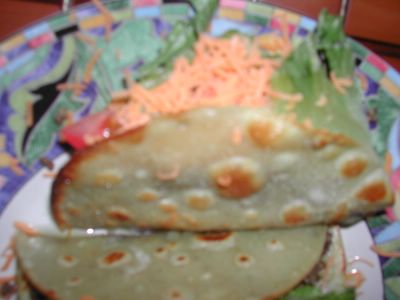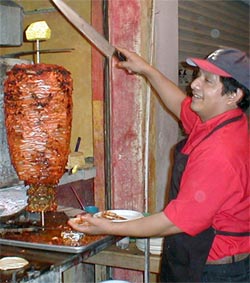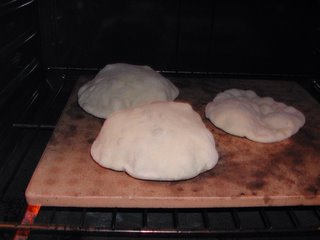The first part of making my NY style pizza is research. To begin, I must define what it is I am looking for in my pizza. When you say 'NY style pizza' you are using a very nebulous term. It can mean anything from the individual slices served at Ray's (located on almost every corner) to the artisan pizzas served at famous pizzerias. If you ask a New Yorker what the best pizza is he will probably tell you about the neighborhood pizza place. You run into the same problem when you try to define 'Chicago Style Deep dish.' There is a deep dish pizza place on every corner and everyone from Chicago has a different idea of what constitutes the perfect pie.
I started by looking into the history of NY pizza. The first pizzeria in New York was opened by Gennaro Lombardi in 1905. You can still get pizza at
Lombardi's today.
Lombardi's makes pizza in a coal fired oven.

Since Gennaro Lombardi was from Naples, I must assume that his recipe is very similar to Pizza Napoletana. Lombardi's Pizza looks a lot to me like pizza Margherita.

Pizza Napoletana is pizza made according to the traditional methods used to make pizza in Italy. Luckily I didn't have to go to a great deal of work to figure out exactly what that is. There is a book on the subject called
Pizza Napoletana.
I have made many of the pizzas out of
Pizza Napoletana
and they were amazing. If you read the book, you will learn all about the history of Pizza Napoletana, including the fact that in 1998 the Italian government decided to define it precisely. An organization was formed by a bunch of Naples pizza makers in the mid 1990's called
Associazione Vera Pizza Napoletana to defend the integrity of their product. The
VPN came up with a set of standards based on the work of Carlo Mangoni, a professor at the Second University of Naples. He made a
42 page document that outlined the historical roots of pizza and did studies on the processes and ingredients used by 40 Neapolitan pizza makers. The book
Pizza Napoletana
has a very in-depth presentation of the research. In Italy there is an organization that is dedicated to preserving the identity of various Italian cultural treasures. It is called the
Ente Nazionale Italiano di Unificazione (UNI). UNI established a Denominazione di Origine Controllata (document of controlled origin) or DOC that defined exactly what pizza Neapolitan is. The DOC defines 2 classic pizzas, pizza marinara and pizza Margherita. The VPN publishes a
recipe on its webpage for pizza Margherita.
You can do a lot more research on the subject of DOC pizza by reading the original
42 page document or by getting the book
Pizza Napoletana
if you are lazy like me.
I have decided to make my New York style pizza as a derivation DOC pizza. I want a pizza that has a bottom that is a little leathery, with an outer rim that is light, airy and with different sized bubbles. My NY pizza will have 2 different kinds of mozzarella - low-moisture part skim and fresh mozzarella. I really like the way pizzas made with the 2 cheeses look. I also plan to depart from pizza Margherita by the addition of pepperoni.
The guys over at
pizzamaking.com have been experimenting for years with NY style pizza. I'll include some of their innovations when I make my pizza. Some of their methods are a little bit
Rube Goldberg-ish for my tastes, but interesting none the less.
This post is an example of what I mean. Look at the lengths this guy goes to just to make the sauce!!! Good GRAVY Batman! I know I get a little crazy with things like BBQ, schawarma and barbacoa but baking your sliced salted grape tomatoes at 150 for an hour and then 10 minutes at 200 is taking it so much farther that I am speechless. I will try to use techniques that the guys at
pizzamaking.com have developed that I think are based on reason and not so much on personal bias. I understand that cooking and recipes have important personal and cultural ramifications. A lot of what you prefer in your food comes from past experiences and your own cultural identity. Some people won't cook anything that isn't made with organic ingredients. For me, whether the ingredients are organic or not doesn't make any difference. I don't carry the whole 'organic only' baggage around and I can not detect a difference in the taste so I am not going to bother with it. As another example, there is a big difference between iodinated table salt and sea salt. But if you get sea salt from France or sea salt from Sicily, it is the same salt. Its the same ocean and the ocean has a relatively constant makeup everywhere around the earth. I know that what I just pointed out would be sacrilege to anyone from either France or Sicily but I am going to try to deal with truth and I don't care if they can't.
Now I need to talk about ingredients. The DOC says that you have to use Italian 00 flour. The VPN specifically recommends
Caputo flour. I have absolutely know way of obtaining Caputo flour. That is OK because I am not going to try making DOC pizza. Here is where the guys at
pizzamaking.com come in handy. They have tried lots of different flours, and the consensus seems to be that the best flour to use is
King Arthur Sir Lancelot flour. It is a very high gluten (protein) bread flour, with 14.2% protein. Another similar, but lower protein content flour is Gold Medal Bread flour. I can't get KASL. I have to play the cards I have been dealt. For my pizza I will use Gold Medal Bread flour.
The DOC also specifies that sea salt is to be used in making the dough. I always use sea salt anyway, so that will be the salt that I use. The DOC specifies Brewer's Yeast. I will vary at this point, as I prefer using Red Star instant yeast. I am used to using that yeast and I know how it will behave under the various conditions in my kitchen.
The DOC has regulations for tomatoes. The tomatoes can be either fresh or canned. It is OK to use canned tomatoes when fresh tomatoes aren't available. The tomatoes have to be one of the three following varieties: San Marzano, Corbara or Carbarini. The tomatoes are to be drained and chopped and placed directly on the dough. I will depart from the DOC on this point. I will include my pizza sauce recipe later.
The DOC specifies that the pizzas not be over 12 inches in diameter. Most NY pizza I have eaten in NYC has been of the 16 inch + variety. My pizza peel will not accommodate a pizza over 12 inches, so I am going to stick with the DOC guidelines for my dough.
Water content and water type is another touchy subject. The ocean doesn't vary that much from region to region in the world, but fresh water sources vary hugely. The best tap water I have ever had was in Chicago - personal bias. Where you are getting your water from probably will make a difference in the taste of your pizza and the rising characteristics of the yeast. For instance, the pH of tap water varies widely from city to city. pH has a huge effect on how yeast grows. Other things like mineral content also make a difference in how yeast grow and how your dough will taste. For NY style pizza, you should probably use NY City water. Unfortunately it would be way too much trouble for me to get it, so I am going to use Kansas City tap water. As far as water content goes, the guys over at
pizzamaking.com consider Tom Lehmann's New York Style Pizza recipe to be 'the authentic' NY style dough recipe. You can see the original recipe for
Tom Lehmann's New York Style Pizza by clicking the link. The number that the
pizzamaking.com guys have arrived at as the perfect water content is 63%. I decided to go with the results of their experimentation when choosing the water content of my dough. I will dial up the water content of my dough until I get the desired results. From my experience, if you want different sized bubbles, you want high water content. The problem comes when you try to form a high water content dough into a pizza. What I plan to do is adjust the water content upwards until I can no longer work the dough. I will depart from Tom Lehmann's recipe in the fact that I will not use oil in my dough.
An example of the formulas derived by the guys at
pizzamaking.com:
Flour 100%
Salt 1.75%
Olive Oil 1.0%
Yeast 0.75%
water 63%
The VPN recipe follows the formula:
00 flour 100%
water 58.8%
salt 2.5%
brewer's yeast 1.25%
As you can see, the salt content is higher in DOC pizza and the water content is lower. The
pizzamaking.com guys have also modified the recipes to use less yeast. I first came across this idea when I was learning to make bread from My favorite book on bread,
The Bread Baker's Apprentice,
by Peter Reinhart. He uses an even lower yeast content but uses a higher water content. Here is Peter Reinhart's formula for Pizza Napoletana:
High-gluten flour 100%
Salt 2.2%
Instant Yeast .54%
Oil 9.9%
Water 69.1%
The formula I will use for my first dough is:
High-Gluten Flour 100%
Sea Salt 2.25%
Instant Yeast 0.75%
Water 63%
How To Use Baker's Formulas (and why you should)I first learned to use baker's formulas when I was learning to bake bread. My favorite book on bread,
The Bread Baker's Apprentice,
has a very good description of how to use the formulas and why you should do so.
For one thing, my cup of flour is not the same as your cup of flour. If I dip into a bag and take out a cup of flour, it will have one weight. If you do it, you will have another weight. If you make your recipes by volume instead of weight you might be able to reproduce the results but someone else might not. Another thing that cooking with weight and baker's formulas allows is scaling of recipes. You can take the DOC recipe above and make enough for 500 pizzas or enough for 1 pizza. The dough will be the same. If you tried to scale recipes using cups of flour, every time you took a cup you would be compounding the error further. Baker's formulas enable you to keep track of very small changes in your recipes over time so that you can vary one ingredient at a time and make note of the result. Enough said. I bake using weights and baker's formulas. Here is an example of how to do it, and several formulas you will need.
1) Total Flour Weight = 100%
2) Total percent is the percentage of all ingredients added up and is always >100%. and is expressed as a ratio of 1. For example 164% = 1.64.
3) Ingredient weight = ingredient % X total flour weight.
4) Total flour weight = total weight divided by total percent.
Lets work through an example. Take the formula for classic French bread and scale it to 10 pounds of dough.
Classic French Bread100% flour
60% water
2% salt
2% yeast
The total percent of that recipe is 164% (100 + 60 + 2 + 2) and expressed as a ratio of 1 it is 1.64. So if you want 10 pounds of dough, your total weight is 10 pounds.
TFW = TW/TP = 10 lbs / 1.64 = 6.097 pounds of flour. Now that we know the TFW we can calculate the weights of all of the other ingredients. I find it a lot easier to work in grams instead of ounces so I will convert 6.097 pounds to grams. 6.097 lbs X 16 oz/pound X 28.5 grams/ounce = 2780.2 grams.
Now we will calculate the water content. Ingredient weight = ingredient % X total flour weight. Again, ingredient % is expressed as a ratio of 1.
water weight = 0.6 X 2780.2 grams = 1668.1 grams or 1.668 liters of water.
Salt weight = 0.02 X 2780.2 grams = 55 grams of salt
yeast weight = 0.02 X 2780.2 grams = 55 grams of yeast.
So using the bakers formula, we have scaled the recipe for classic French bread to make 10 pounds of dough.
2780.2 grams flour
1668.1 grams water
55 grams salt
55 grams yeast
To check your conversion, add up the weight of the ingredients. In this case the total weight = 2780.2 +1668.1 + 55 + 55 = 4558.3 grams. To be absolutely sure, you could go to the trouble of converting grams back to pounds. 4558.3 grams/ 28.5 grams/ounce = 159.9 ounces. There are 16 ounces in a pound so 159.9 oz/16 = 9.99 pounds. It doesn't add exactly up to 10 pounds because I rounded after 1 decimal place. My scale doesn't go past 1 decimal place so it doesn't make any difference if the final weight is 0.01 pounds off. My scale can't measure the difference.
The next step in applying the formula is to figure out exactly how much dough you will need to make a 12 inch pizza. My pizza peel can only accommodate a pizza of 12 inches in diameter. There is an excellent discussion of how to convert baker's formulas into pizza dough formulas
here. Briefly, to get the total weight in ounces for a specific size of pizza, the formula is:
total weight = 3.14 X R X R X thickness factor
R = radius of the pizza. For a 12 in pizza R = 6.
The thickness factor is a constant that has been worked out for various types of pizza. The guys over at
pizzamaking.com have experimented and the consensus seems to be that the best thickness factor for New York Style pizza is 0.1. I will benefit from the results of their experimentation and use 0.1 as the thickness factor for my first attempt.
For my pizza I need a total weight of:
3.14 X 6 X 6 X 0.1 = 11.3 ounces or 322 grams
Calculating the recipe for my doughI will use this formula to make my dough:
High-Gluten Flour 100%
Sea Salt 2.25%
Instant Yeast 0.75%
Water 63%
According to my calculations, the total weight of my dough needs to be 322 grams. The total percent for my formula is 100 + 2.25 + 0.75 + 63 = 166.
total flour weight = 322 grams / 1.66 = ~194 grams
salt weight = 194 grams X 0.0225 = 4.3 grams (just a touch over 3 grams)
yeast weight = 194 grams X 0.0075 = 1.5 grams (might be hard to weigh this accurately)
water weight = .63 X 194 = 122 grams
To check my math, total weight of my dough = 194 + 4.3 +1.5 + 122 = 321.8 grams. I was shooting for 322 grams, and like I said above, the difference of 0.2 grams is not measurable by my scale, so I will have to accept a little bit of error. 0.2 grams is only an error of 0.06%, and yes that number is correct. I can't measure ingredients more precisely, so I am just going to have to accept 0.06% variance in my experiments. Oh well, I'm sure I will survive.
AND NOW FINALLY AFTER ALL OF THOSE CALCULATIONS, MY DOUGH RECIPEGold Medal Bread Flour 194 grams
Sea Salt 4.3 grams
Red Star instant yeast 1.5 grams
Kansas City tap water 122 grams
That is it for now. In my next post I will delve a little into the processing of the dough.











